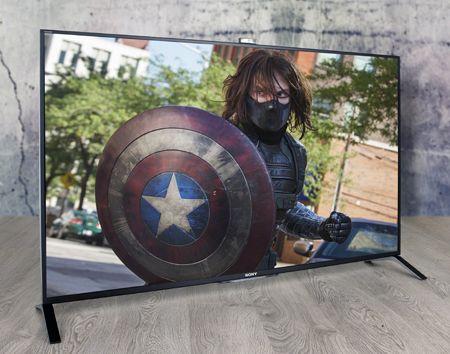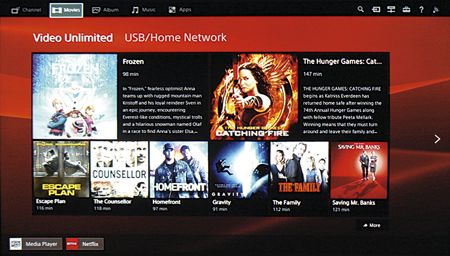Sony KD-55X5805 review

While Sony’s flagship 4K TVs for 2014, the X9005B series, are magnificent performers, they represent a considerable challenge for your average UK living room. Firstly, they’re not cheap, and secondly – not to put too fine a point on it – they’re absolutely massive. Don’t get me wrong – I still find the X9005B series highly attractive, with spectacular front-firing magnetic fluid speakers etched into their huge frames. But they really do eat up your real estate.
Cue the 55X8505. This 55in model is the first 4K TV from Sony to ditch the big forward-firing speakers, enabling it to sport an extremely compact if slightly ‘functional’ design that’s essentially just a slim black rectangle sat atop a pair of minimalistic black legs – legs which can be positioned either at the screen’s extremities or closer together under its centre, depending on the width of your support furniture.
Connectivity is up to snuff for a 2014 display, with two of the set’s four HDMIs built to the v2.0 spec to support 4K at 60fps and the HDCP 2.2 standard. The 55X8505 also provides three USBs for direct multimedia file playback from USB storage devices and recording from its twin built-in Freeview HD tuners, as well as network connectivity to support both multimedia streaming from DLNA devices and access to Sony’s online platform. The includes catch-up apps for the BBC and Channel 5, as well as the Netflix and Amazon Instant subscription-based video streaming platforms. And yes, HEVC-encoded 4K material via Netflix plays out fine.
It's not a bad Smart platform, but you don’t get 4OD or ITV Player, and nor can you watch one channel from the TV on a smartphone or tablet while another plays on the TV, despite the presence of two tuners. Other brands have brainier systems.
The 55X8505 joins the flagship X9005B series in carrying Sony’s 4K X-Reality PRO video processing engine as well as Triluminos for a wider colour gamut. However, it uses a totally different source panel: an IPS one. This means that, again, I have to worry about the difficulties that IPS panels have producing a convincing contrast performance. Still, perhaps Sony, given its well-established local dimming prowess, can surprise me.
And what are the other key differences between the 55X8505 and the X9005B series? Notably, this thinner model doesn’t support X-Tended Dynamic Range picture technology, meaning its contrast range won’t seem as extreme. And obviously the speakers are very different here, being down-firing bass reflex designs.
One last key spec change, necessitated by the IPS panel, is the 55X8505's employment of a passive 3D system, rather than the active shutter iteration found on the X9005Bs.

How good the 55X8505’s pictures are depends 100 per cent on the type of content you’re watching and the room conditions you’re watching it in. Which actually translates into them being rather a disappointment for serious home cinema fans.
The problem, inevitably, is the lack of black level response, courtesy of the IPS panel. Compared with the glorious dark tones delivered by the X9005B, this more affordable screen is hugely disappointing with shadowy material – Batman’s ill-fated fist fight with Bane in the tunnels beneath Gotham in The Dark Knight Rises lacks serious punch [nice pun – Ed]. There's a grey mist that no amount of backlight reduction or dynamic contrast action can remove. At least consistently.
For that’s the other problem. The extremes the 55X8505 has to go to with its dimming and luminance adjustments to fight against its low-contrast core can cause frustrating brightness jumps and shifting patches of backlight clouding.
It's not completely incapable of delivering a convincing black colour, however. With a really dark shot it works better than any other IPS-based TV I've seen this year. But as soon as any significant light enters the frame the greyness level and backlight clouding ramp up alarmingly.
The problem is especially egregious when watching films with aspect ratios wider than 1.85:1. Which happens quite a lot, actually.
These issues are much less obvious if you’re watching in a bright room. And you don’t have to worry about them if you’re watching consistently bright, colourful content. However, if you routinely darken your movie room when spinning a Blu-ray, and those discs routinely contain a few dark sequences, then you’ll sometimes find yourself watching the backlight engine more than you’re watching the film. Disappointing.

In most other ways the 55X8505 displays all the hallmarks of Sony’s excellent imaging engine. Colours are terrific, with a wonderful Triluminos-inspired richness joined by immaculate subtlety. Even more impressive is the way the TV serves up healthy amounts of shadow detail in dark scenes despite the black level problems. It’s better in this regard than its rivals, proving just how clever Sony’s core light management is. If only this light management was being applied to a less contrast-compromised panel...
Native 4K feeds look detailed and crisp too; 4K is more than capable of blowing HD out of the water even at the relatively small 55in screen level. There’s a greater sense of depth and object solidity thanks to the 4K resolution, making even 2D images feel a bit 3D.
Upscaled HD, which will make up the majority of your viewing time while we wait for more native 4K sources, is handled majestically. The Sony conjures a sense of improved sharpness and pixel density without generating irksome extra noise.
Motion handling is also top-notch, managing to remove almost all blur and judder using the 55X8505's Clear setting without generating any significant side effects. This is great news for native 4K content in particular.
Firing up Thor in passive 3D, the reduction in resolution from native and even upscaled HD feels more noticeable than I would have expected, actually. Fortunately the stereoscopic images are bulletproof where crosstalk ghosting and flicker are concerned, and enjoy vivid colours and bold brightness levels. However, since the panel is run brightly for maximum 3D impact, you can see more signs of the TV’s backlight foibles during dark 3D scenes, such as when the scientists drive into the desert to investigate the light phenomenon that precedes Thor’s arrival.
Not surprisingly the super-skinny 55X8505’s sonic abilities fall well short of the incredible efforts of the X9005B series. There isn’t much bass, leaving the soundstage rather thin and harsh during action scenes. Male voices sound rather forced and boxy, too. The set can hit serious volumes without distorting or rattling though, and its Cinema audio setting did actually manage to steer some effects behind me in my viewing room, as well as offering an expansive front soundstage.
With its aggressive price and relatively manageable dimensions, I wanted to love the 55X8505. And for much of the time it is quite lovable, with bright, colourful, and stunningly detailed pictures. But unfortunately even Sony’s best picture processing efforts can’t disguise the fundamental contrast flaws at the TV’s heart.
Specification
3D: Yes. Passive
4K/Ultra HD: Yes. 3,840 x 2,160
Tuner: Yes. Freeview HD x 2; DVB-S2
Connections: 4 x HDMI; 3 x USB; component video input; composite video input; Scart input; integrated Wi-Fi; Ethernet; subwoofer output; optical digital audio output; analogue audio input; headphone output
Sound: 20W
Brightness (claimed): N/A
Contrast ratio (claimed): N/A
Dimensions (off stand): 1,232(w) x 741(h) x 66(d)mm
Weight (off stand): 23.5kg
Features: 4K X-Reality PRO processing; Triluminos colour; IPS panel; multimedia playback via USB and DLNA; Twitter tracker; Sony Entertainment Network portal; BBC iPlayer/Demand 5 catch-up; MotionFlow XR 200Hz; Advanced Contrast Enhancer; numerous picture presets including Cinema1, Cinema2, Vivid and Standard
 |
Home Cinema Choice #351 is on sale now, featuring: Samsung S95D flagship OLED TV; Ascendo loudspeakers; Pioneer VSA-LX805 AV receiver; UST projector roundup; 2024’s summer movies; Conan 4K; and more
|

















































